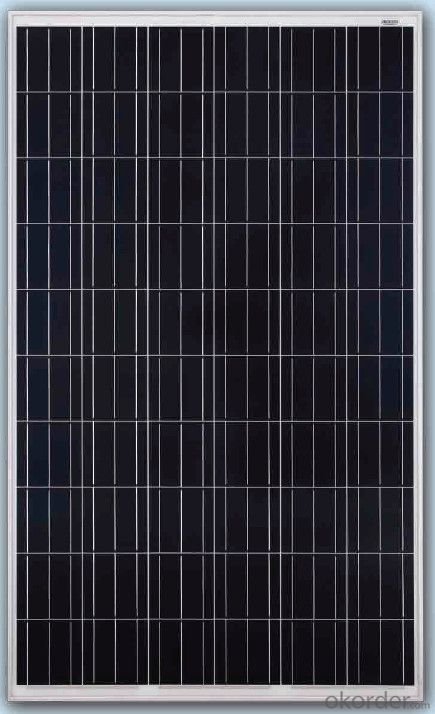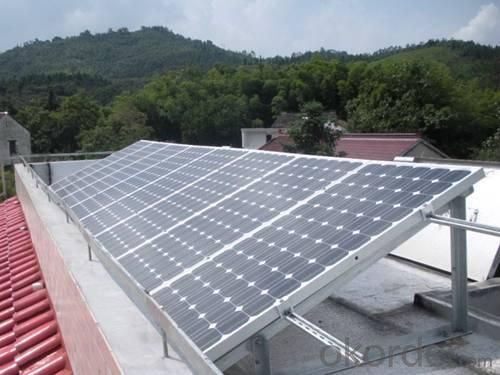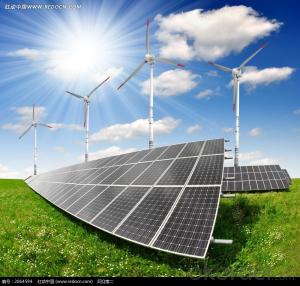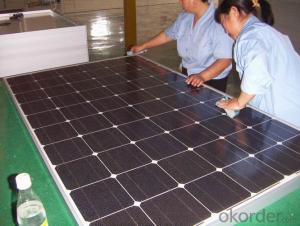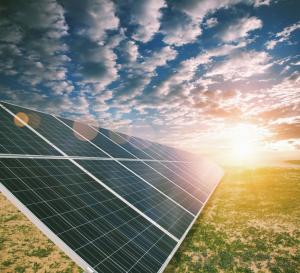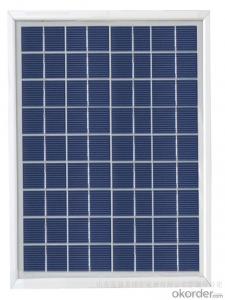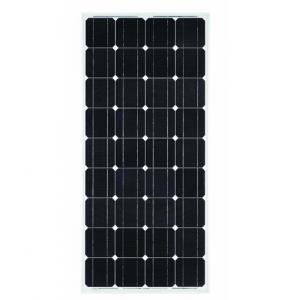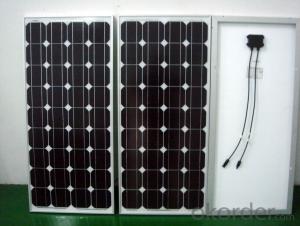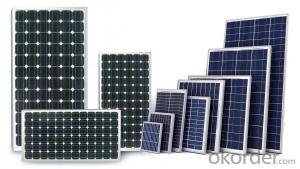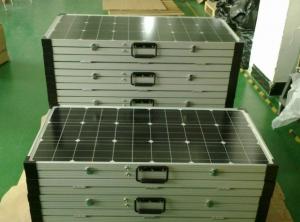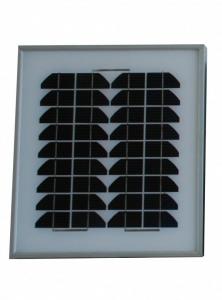Buy Your Own 140w/145w Solar Panels with TUV IEC MCS CEC IDCOL SONCAP Certificates
- Loading Port:
- Shanghai
- Payment Terms:
- TT OR LC
- Min Order Qty:
- 1000 watt
- Supply Capability:
- 100000000 watt/month
OKorder Service Pledge
OKorder Financial Service
You Might Also Like
- TUV IEC, MCS (UK), CE, CEC (Australia), INMETRO, IDCOL, SONCAP CERTIFIED
- [EU ANTIDUMPING DUTY-FREE]
- PROFESSIONAL SOLAR PANEL MANUFACTURER SINCE 2004
FEATURES
`Long Service Life
`High Efficency Solar Cells
`Special Aluminum Frame Design
`High Transmission,Low Iron Tempered Glass
`Advanced Cell Encapsulation
APPLICATIONS
`Solar power stations
`Rural electrification, Small home power systems
`Power supply for traffic, security, gas industry
`12V and 24V battery charging system
`Other industrial and commercial applications
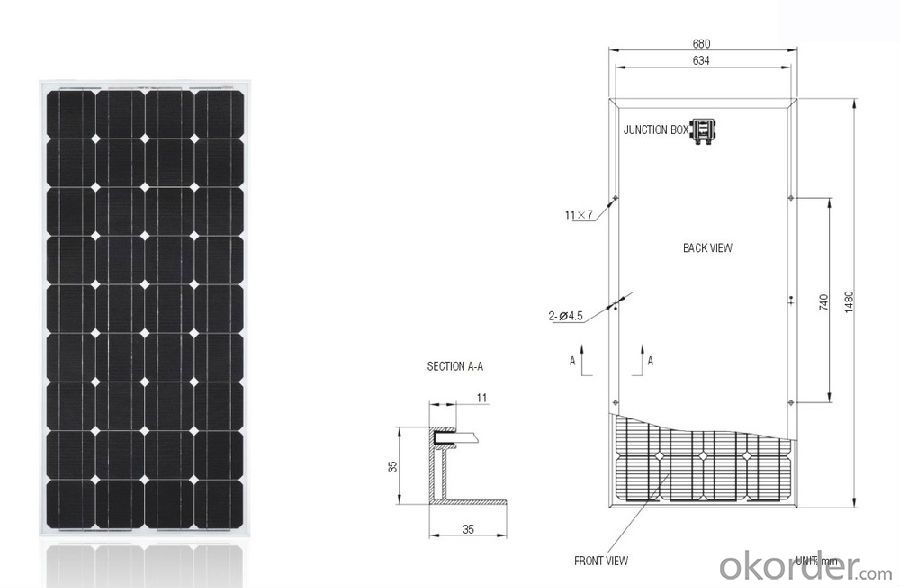
ELECTRICAL CHARACTERISTICS | ||||||
Model Number | KM130(6) | KM135(6) | KM140(6) | KM145(6) | KM150(6) | |
Maximum Power as per STC | Pmax(W) | 130 | 135 | 140 | 145 | 150 |
Power Tolerance | % | ±3% | ||||
Maximum Power Voltage | Vm(V) | 17.96 | 18.14 | 18.36 | 18.15 | 18.28 |
Maximum Power Current | Im(A) | 7.26 | 7.45 | 7.65 | 7.99 | 8.21 |
Open Circuit Voltage | Voc(V) | 21.6 | 21.74 | 21.96 | 21.72 | 21.9 |
Short Circuit Current | Isc(A) | 7.83 | 8.04 | 8.17 | 8.69 | 8.93 |
Maximum System Voltage | VDC | 1000 | ||||
Cell Efficiency | % | 15.0 | 15.5 | 16.1 | 16.7 | 17.3 |
Module Efficiency | % | 12.9 | 13.4 | 13.9 | 14.4 | 14.9 |
Cells per Module | Pcs | 36 | ||||
Cell Type | Monocrystalline silicon | |||||
Cell Size | mm | 156 x 156 | ||||
Bypass Diodes | Pcs | 10Amp, 2 pcs | ||||
Max. Series Fuse Rating | A | 10A | ||||
Temperature coefficient of Isc | %/°C | 0.05 | ||||
Temperature coefficient of Voc | %/°C | -0.35 | ||||
Temperature coefficient of power | %/°C | -0.47 | ||||
NOCT- Nominal operating cell temperature | °C | 47 ± 2 | ||||
Operating Temperature | °C | -40 ~ +85 | ||||
MECHANICAL CHARACTERISTICS | ||||||
Dimensions | mm | 1480 x 680 x 35 | ||||
Weight | Kg | 11.6 | ||||
Type of Junction Box | TUV certified, IP65 | |||||
Cable Type, Diameter | - | |||||
Connector | - | |||||
Tempered Glass | 3.2 mm, high transmission, low iron | |||||
Packing
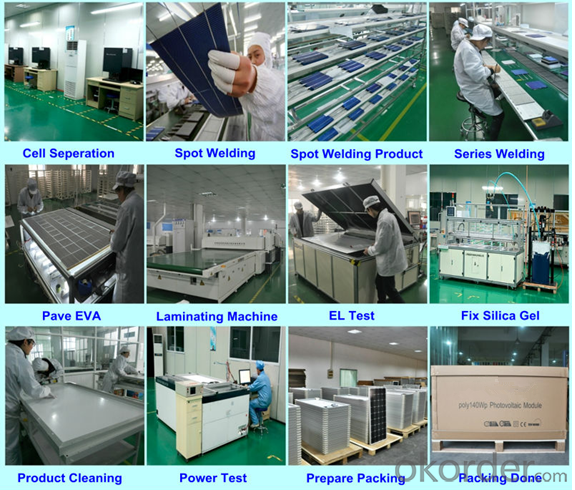
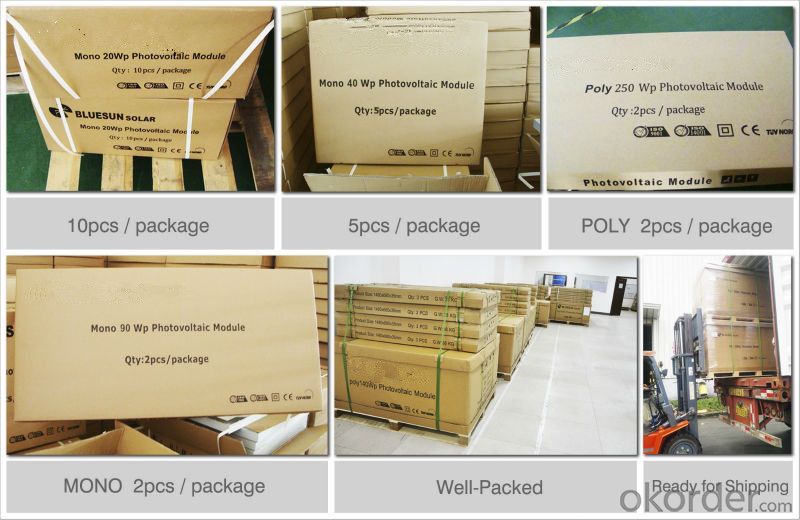
FAQ
1. What kind of Solar Cells does it have
---poly crystalline 156*156mm and 125*125mm or mono 125*125mm and 156*156mm
2. Is the front panel Glass or Plastic
---Tempered glass 3.2mm thickness or adjust to what you need, Light transmittance up to 95%.
3. Does it meet Europe Standards for Solar Energy
---This is TUV approval products, all the producing procedure apply TUV&UL.
4. What is the Efficiency level
--- Between 16-18.9% for solar cells.
5. What is the Nominal Voltage
--- 18v 20v 24v 36v 30v 48v , and so on, we can adjust to what you need.
6. What is the Warranty Period, How many years?
Power efficiency warranty:
---90% in 10 years; 80% in 25 years.
- Q: solar panels!!they are fantastic! cause they are the new way of quot;chargingyour home, without killing the earth!would you install them, or not? and make sure you say WHY
- I believe the best economy comes out when a completely green house is built. Solar panels are expensive, and I'll rather use some of the investments to build different back-up systems, instead of bying solar panels for it all. If I build another house, my fancy stuff would be the green stuff. The house will have a water radiator heating system and a heat pump to circulate warm or cold air in the house. Heat pump also used to heat water for heating system. I'll use solar panels to make enough electric power . charging a deep cycle battery pack for back up power, 2. to power heat pump, fridges., freezers, and water pumps, when I'm not home at the house. When I'm home I'll run a bio-fueled(bio-waste and pellets or firewood) powered steam engine with a 0KW 0-220V generator when I need electric stove and oven, dishwasher and laundry appliances. I'll use a wood stove, BBQ and oven on the porch for summer cooking. I'll use excessive heat from steam engine for heating water tank. I'll also have an bio-fueled (waste and pellets or firewood) water heater for winter heating back-up. Of course I'll make sure I'm connected to the electric grid, so I can get credit from power company for the excessive electricity that will occasionally come out from solar panels. Steam engine can be replaced by diesel powered 0KW generator, if it's possible to fuel it with veg-oil home made diesel fuel. Depends whats most accessible at my living site.
- Q: Can solar panels be used for powering water treatment plants?
- Yes, solar panels can be used for powering water treatment plants. Solar energy can be harnessed through photovoltaic panels to generate electricity, which can then be used to power the various processes involved in water treatment plants. This renewable energy source offers a sustainable and environmentally-friendly solution for powering water treatment facilities.
- Q: What about sources for straight forward solar powered products? Excluding toys, garden frogs and outdoorpath lights I have found few useful items for the home. What I have found are solar panels for under $00 each, inverters, rechargeable indoor lights and a few camping/RV products that are interesting. It seems to me that these could help me start to wean the family off the power company. I can't afford to go cold turkey and cover my roof with solar panels and I don't think the HOA would allow me to even if I could. Is anyone using solar on a small scale?
- I have an active solar heater on my roof. During the winter it comes in handy and heats the house, though we still need to use a gas heater to get the temperature up to a comfortable level.
- Q: can this amount of solar charge these batteries.
- Wow I think that your battery are too big or in othercase your solar system panels are too small. But making some calcs if you connect your panels in parallel you will have 30 Amps of Recharge for your batteries. Assuming that your batteries are discharged to .75 V/C you will need at least (. x Ah removed)/Recharge Amps = (. x 550Ah)/30A, that means that you will need 20 Hours to recharge your batteries Literally this is imposible to have fully charged your batteries for a proper application you will need 65 Amps from your panels to recharge your batts in 4 hours or de-rate your batteries to 00 Ah
- Q: i want to instal solar ligth in my garden
- hello, okorder /
- Q: I have a cabin in the woods and need more light. I do have enough sun but I was wondering how or where do I get a solar panel to lead to a power outlet? In a perfect world I would like to get a solar panel with a connecting wire to an outlet or something so I could power a small TV. I know its hard enough but can I get that pre-made? Or even lastly should I look at wind power consider I would like this to be under $500? Thank you for putting up with this bundle of questions.
- First okorder /
- Q: Okay, I think I understand what I'm doing, but I want to set up some solar panels on the roof of my garage, the building that gets the most sun, and I want to make sure all my math is correct in determining number of megawatts per year. However, my knowledge of electrical terms in quite n00bish, to say the least.Here is what I think I should be doing.The solar cells come at .75 Watts average power.I will install 4 panels of 64 cells each, with a total of 256 cells.
- For comparison, 36 of these make a normal 2V x 50W panel. Note they are not tabbed. This means you have to find a way to connect them yourself. The tabs are probably spot welded on by the suppliers. A supplier below has kits of these with tabs, as needed to connect them together. These are not suitable for grid connect, because the higher voltage needed makes do it yourself panels a dangerous and litigious thing to have on your roof. Maybe you could buy a smaller pack from the link below to compare tabbed and untabbed and work out what to do. Your power calculation is a bit incorrect because the sun is only present some of the time. The 36 cell module would produce 50W when square on to the full sun. The sun may be out for around 2h a day in some places and times of the year. However it is the equivalent of 5h full sun, because of the changing angle throughout the day. Look this up on the internet for your region. Temperate zones may be a lot less. One pack in your link is 36x3 = 08 cells. Thus 50W per pack x 5h a day gives 750Wh per day and 274KWh/y. In reality it will always be less because of regions, weather, clouds, dust, inefficiencies, aging of cells.
- Q: i want to how i make solar panels
- if you want to make a photovoltaic panel from scratch, its extremely difficult, comparable probably to making integrated circuits. just buy a factory built panel solar-thermal is much easier
- Q: I'm trying to charge rechargeable AA batteries with a solar panel. What gauge wire should I use to connect the panel to the batteries? I know I'm not going to have a lot of current going through so the wire size doesn't really matter. Can the wire be too thick thoShould I ugh? Should I use a diode to keep the batteries from overpowering the circuit? If so, what size diode? My panel is 4.8V 50mA. Can I just hook the panel straight into the batteries or do I need something else?
- In order: .? Just about any wire will do.? You can handle 50 mA over just about anything, even 28 gauge telephone wire.? Your biggest problems are probably going to be mechanical stress (you want stranded wire instead of solid, to avoid breakage) and dealing with the size of larger wires. 8 gauge speaker wire may be a good optimum. 2.? You need a diode.? If you're charging NiMH or NiCd cells you're going to have about .25 volts/cell; you can charge up to 3 of them in series with a 4.8 volt panel.? The solar panel is a bunch of diodes itself, but they're leaky in the reverse direction; the diode prevents the batteries from discharging themselves back through the panel.? You want a Schottky-barrier diode, because the forward voltage drop is about 0.2 volts instead of 0.7 volts for a regular silicon rectifier.? This gives you maximum current output from your panel.
- Q: So idk how to connect a solar panel to a battery ...is it like a series connection from the solar panel to the battery, or a parallel connection from solar cell to battery? (to charge) please and thank you
- it depends how big the panel is. a small trickle charger (like a 2W panel with built-in diode), just connect + to + and - to - (parallel) to trickle charge the battery. The diode will keep the batter from discharging through the panel when there is insufficient sunlight. for a large panel (like a 220W 24v panel), you best go through a charge controller. the charge controller has 2 leads for the solar panel input, 2 leads for the battery connection and 2 leads for the 2v load. just follow the instructions to connect the panel and battery to the controller, and MAKE SURE YOU USE THE REQUIRED FUSES. very straightforward stuff -- just RTFM
Send your message to us
Buy Your Own 140w/145w Solar Panels with TUV IEC MCS CEC IDCOL SONCAP Certificates
- Loading Port:
- Shanghai
- Payment Terms:
- TT OR LC
- Min Order Qty:
- 1000 watt
- Supply Capability:
- 100000000 watt/month
OKorder Service Pledge
OKorder Financial Service
Similar products
Hot products
Hot Searches



